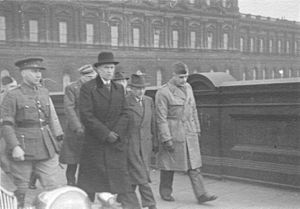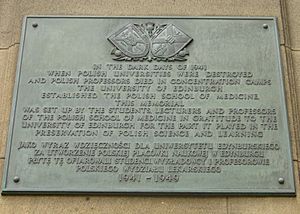Polish School of Medicine facts for kids
| Active | 1941–1949 |
|---|---|
| Students | 336 |
| 19 | |
| Location |
Edinburgh
|
| Language | Polish |
The Polish School of Medicine at the University of Edinburgh was a special medical school. It was created in March 1941 during World War II. The main idea was to train doctors for the Polish Armed Forces. But it also welcomed regular students. This unique school was set up through an agreement. It was between the Polish Government in Exile and the University of Edinburgh. This allowed Polish students to finish their medical degrees during the war.
Most teachers were Polish professors and staff. They had become refugees after the Invasion of Poland and the Fall of France. Professors from Edinburgh University also helped teach. Professor Antoni Jurasz was the first leader of the school. Students first learned in Edinburgh Hospitals. Later, in October 1941, the Ignacy Jan Paderewski Polish Hospital opened. Most classes were taught in Polish. The school followed the Polish medical plan. Students earned a Polish medical degree.
The school closed in 1949. By then, over 336 students had joined. 227 students earned a medical diploma. Also, 19 doctors earned a higher degree (like a PhD). After the war, most graduates stayed in Britain. Some moved to the US, Canada, or Australia. Only a few went back to Poland. This school was the only official Polish university operating during World War II.
Contents
Why the School Was Created
After Poland and France were taken over, Polish soldiers moved to Great Britain. A big problem was finding enough doctors and pharmacists for the army. Many medical students had their studies stopped by the war. Luckily, there were also Polish professors and teachers who had worked at medical schools before the war.
The idea for the school came from Professor Francis Albert Eley Crew. He was in charge of a military hospital in Edinburgh. Polish supporters included Professor Antoni Jurasz and Professor Tadeusz Sokolowski. The University of Edinburgh agreed to the idea. The Polish Government in Exile also approved it. Professor Antoni Jurasz led the talks with the University of Edinburgh. A group was formed to set up the school.
The University of Edinburgh and the Polish group made an agreement. It said the Polish School of Medicine (PSM) would:
- Follow the same academic rules as other Polish universities.
- Be free to organize itself like universities in Poland.
- Be able to test students and give degrees. These degrees would be recognized by the Polish Government.
- Hire teachers from Polish universities. These teachers needed approval from Edinburgh University.
- Have Edinburgh University professors teach classes if no Polish teacher was available.
The official agreement was signed on February 24, 1941. It said: "The University of Edinburgh and the Government of Poland want to make their countries closer. They agree to create a Polish School of Medicine at the University of Edinburgh from February 24, 1941."
On the same day, the Polish President announced the school's creation. In January 1941, the Polish army ordered all medical students to go to Edinburgh. Polish newspapers also announced that civilian students could join. The school officially opened on March 22, 1941. The Polish President, Wladyslaw Raczkiewicz, was there.
Teachers at the School
When the school opened, many professors and lecturers joined. They taught different medical subjects. These teachers came from various Polish universities. For example, there were 7 professors from Kraków, 7 from Poznan, 6 from Lwow, 6 from Warsaw, and 1 from Vilnius. Some teachers had not been professors before the war.
Here are some of the main leaders of the Polish School of Medicine:
- 1941–1945: Professor Antoni Jurasz
- 1945–1946: Professor Tadeusz Rogalski
- 1946–1949: Professor Jakub Rostowski
Student Life and Graduates
At first, 70 students from the military and 20 civilians joined the school. Polish students at the PSM were also full-time students of the University of Edinburgh. This meant they had the same rights as other Edinburgh students. The Polish government paid for their studies, including a small fee.
The University of Edinburgh highly respected the courses at the PSM. Students attended classes in the College of Medicine buildings. They also got hands-on training at hospitals like the Royal Infirmary. From October 1941, students also learned at the Paderewski Hospital. This hospital was located near the Western General Hospital.
Polish teachers were allowed to work as doctors in the UK during the war. This helped them teach students in Scottish hospitals. The Scottish community was very supportive of the Polish students. In December 1941, a student dorm opened for PSM students.
Just four months after the school opened, on July 17, 1941, the first medical degree was given. It went to Konrad Bazarnik. He had been a medical student at Kraków Jagiellonian University. More degrees were given in December 1941. After graduating, many students joined the Polish military.
Closing the School
After World War II ended, the future of the PSM was unclear. On July 5, 1945, the British government stopped recognizing the Polish Government in Exile. Because of this, the University of Edinburgh and the PSM decided to slowly close the school. No new students would be accepted. However, students already studying could finish their education.
In the 1944/45 school year, there were 246 students. This number dropped to 209 in 1945/1946. Over the next three years, the school gradually closed down. In 1946, 33 third-year students moved to British universities. The PSM finally closed its doors on March 30, 1949.
During its 8 years, 336 medical students joined. 237 finished their studies. 227 earned a medical degree. 19 earned a higher degree (MD or PhD). Some students left or were asked to leave due to poor progress. Doctors linked to the PSM published 121 scientific papers. The school's library had 1076 books. These were later moved to the University of Warsaw Library and the Polish Library in London.
On November 15, 1949, a special plaque was put up. It is in the Medical Quadrangle in Edinburgh. The plaque has words in both English and Polish. It thanks the University of Edinburgh for helping Polish science and learning during the war.
Life After Graduation
After the war, most PSM graduates chose not to return to Poland. Many faced challenges finding medical jobs in the UK. This was because many British doctors were returning home. Also, the PSM degrees were not immediately recognized by the British medical council.
This changed on December 18, 1947. The British parliament passed a law that allowed PSM graduates to register and work as doctors in the UK. Because jobs were limited in Britain, many graduates worked outside Europe. They went to countries in the Commonwealth. Eventually, 128 doctors settled in Great Britain. Some became very successful. For example, Professor Henryk Urich led a department at London Hospital Medical School. Henryk Maslowski led Neurosurgery in Manchester.
Some graduates stayed in Edinburgh or returned there. Many also settled in the United States and Canada. Eighteen graduates decided to go back to Poland. Some of them became professors. Dr. Olech Szczepski became a professor and leader of the Poznan University of Medical Sciences. Dr. Antoni Kepinski led the Psychiatry department at the Jagiellonian University in Cracow.
The School's Lasting Impact
In 1966, the PSM graduates had their first worldwide reunion. Since then, they have met in Edinburgh every five years. This keeps the spirit of the school alive. It also helps them stay connected with the University of Edinburgh. In 2016, the University of Edinburgh gave special awards to three people. These people helped keep the school's spirit alive. They also helped build connections between Edinburgh and Polish medical universities.
In 1986, for the school's 45th anniversary, the graduates set up the Polish School of Medicine Memorial Fund. This fund was created to thank the university for its help during WWII. It also helps connect Edinburgh University with Polish medical universities. The fund gives scholarships to talented Polish medical scientists. They can come to Edinburgh to study or do research. So far, over 80 Polish scientists have benefited. The fund also supports a lecture series in Poland.
Also in 1986, Dr. Wiktor Tomaszewski started the Polish School of Medicine Historical Collection. He was a senior staff member at the PSM. This collection is now cared for by Edinburgh University. It includes medals, sculptures, paintings, photos, and books about the school. Many items were given by Polish universities, former students, and staff. Part of the collection can be seen in the Polish Room at the University of Edinburgh.
|




